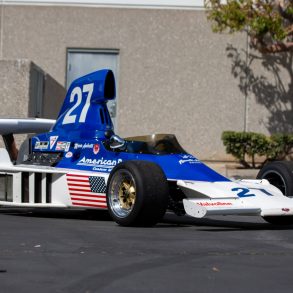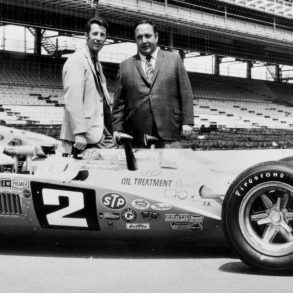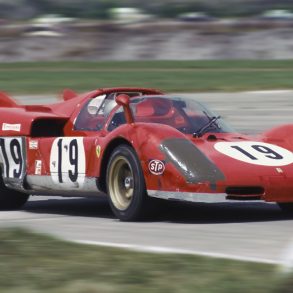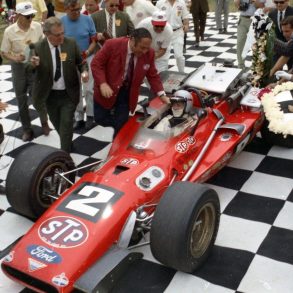Due to the peccadilloes and vagaries of the publishing world, I sit here writing this column in the beginning of May (don’t ask!). In fact, just a few days ago the Indianapolis Motor Speedway officially opened its gates for the month-long high-holiday that is the Indianapolis 500. This year, the month’s festivities were kicked off with a landmark that, to my knowledge, has never before occurred in the history of motorsport. On opening day, three generations of professional drivers from one racing family took to the track at the same time for a few ceremonial laps. This historic family, of course, being the Andrettis with grandfather(!) Mario, son Michael and grandson Marco all whizzing around the track in formation. While it may seem trivial, and a bit of a publicity stunt, it really is something of a milestone that, by my count, only three racing families can lay claim to.
Of course, if you’re talking about racing dynasties like the Andrettis, you have to also talk about the Unsers. Here is a family with top-flight racers not only up and down the family tree, but also laterally across the branches. Like the Andrettis, the Unsers have three generations of professional drivers consisting of Big Al (Sr.), Little Al (Jr.) and now Mini-Al (III). Undoubtedly, it won’t be long before we’ll be hearing about Micro-Al, Pico-Al and Femto-Al. While the Unsers may be a phenomenal racing family, they do seem to lack a certain imagination when it comes to family nomenclature.
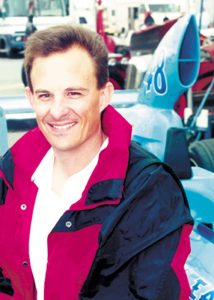
Editor
However, from a historical perspective, while the Andrettis and the Unsers may be the only racing families to have had three generations compete at the highest levels of professional motorsport, they are neither the first, nor surprisingly, the largest. This rare distinction actually goes to the Belgian Pilette clan.
The Pilette racing dynasty started with Theodore Pilette, who began his racing career in 1890 at the wheel of a deDion-Bouton. Not long after, Theodore became a Belgian agent for Mercedes and Bugatti, which opened the door for him in 1913, to compete in the Indianapolis 500 in a Mercedes, where he started 13th and finished 5th. The following year, Theodore notched up what would be his crowning motorsport achievement by racing his Mercedes to a fine 3rd-place finish in the French Grand Prix (Grand Prix de l’ACF) held at the Circuit de Lyon. Sadly, Theodore would lose his life while testing a car in 1921.
At the time of his death, Theodore left behind a three-year-old son named Andre who, perhaps not surprisingly, caught the racing bug after hearing of his father’s heroics. After the end of WWII, Andre began racing in an HRG and various Talbot Lagos, in early postwar sports car events. His prowess at the wheel of the Talbot Lago caught the eye of Gordini who offered him the opportunity to race for the works in 1953. Andre later went on to form the Ecurie Nationale Belge in 1955, and in 1956, raced a Belgian Yellow Lancia-Ferrari D50 in that year’s Belgian Grand Prix. Andre would race more Ferraris in the coming years including a career best 2nd-place finish in the 1960 24 Hours of Le Mans, co-driving a NART-entered Ferrari TR60 with Ricardo Rodriguez. Andre continued to race into the mid-1960s, when his focus turned to a racing school he founded at Zolder and his own son Teddy’s burgeoning racing career.
Teddy Pilette, named after his racing grandfather Theodore, started racing karts at his father’s school in 1960, but soon graduated up to Formula Junior. From Juniors, Teddy Pilette made his way into sports cars with Abarth and then a chance F3 ride enabled him to meet Belgian brewing magnate Count Rudi Van der Straaten, who would become a patron of Pilette’s over the next decade. Racing for Van der Straaten’s Team VDS, Pilette won two European Formula 5000 championships (1973, 1975) and competed in the American center-seat Can-Am championship. Like his father, and his grandfather before him, Pilette also competed at the Grand Prix level driving for both BRM and Brabham in selected races in 1974 and 1977. His best F1 career finish was a 5th, driving a Brabham in the 1974 Belgian Grand Prix.
In recent years, Teddy’s sons John and Alexandre have also followed in the family tradition racing in karts, single-seaters and touring cars, with John winning a Belgian Touring Car Championship. So, with the addition of this fourth generation of drivers, the Pilette family can claim over a 100-year history in professional motorsport, making it arguably one of the earliest and longest family dynasties in racing.
With all this said, none of the three families shows any signs of hanging up their respective helmets, so this is a question that might not be settled for at least another 25–50 years. I hope I’m still around to write about it when one of the families comes out on top!




